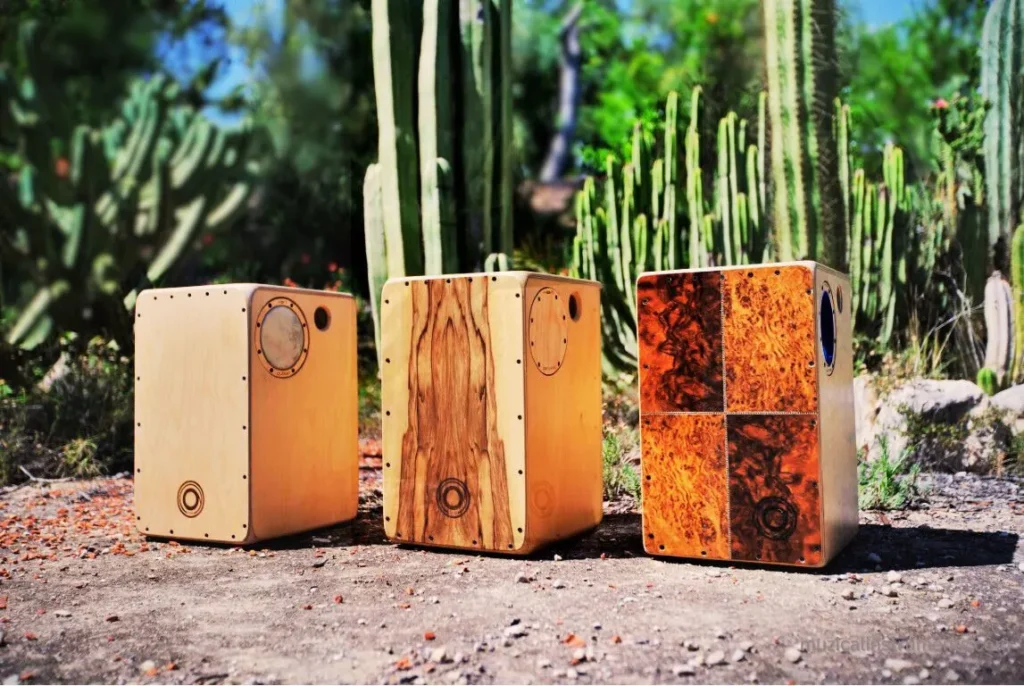Flamenco vs Peruvian Cajón: Which Box Drum Fits Your Beat?
Flamenco vs Peruvian Cajón, both are wooden boxes and look the same. You sit on one, tap the front. But they sound different.
The Peruvian cajón was born long ago in Peru, built by enslaved Africans who had no drums. They used wooden crates to keep the rhythm alive. No wires inside. Just pure wood and heart. You still hear that sound today in Afro-Peruvian music, festejo, and Peruvian waltz.
In 2001, it became Peru’s National Cultural Heritage, and every August 2, people in Peru celebrate Cajón Day.
In 1977, a famous flamenco guitarist, Paco de Lucía, heard the cajón in Peru. He loved it. He brought it to Spain. There, they added guitar strings or snares behind the front board, the tapa. This gave it a sharp, buzzing sound that worked great for flamenco, pop, and even rock.
So, which one is for you? You may want soft beats that feel like the earth, that’s the Peruvian cajón.
Or you may love loud cracks that push your feet to dance, that’s the Flamenco cajón.
Here, you’ll learn their full story, feel their sound, and know which box drum fits your beat.
Let’s open the box.
What is a Cajón? (The Box That Speaks Without Words)
You see a wooden box. Someone sits on it. They tap with their hands. Suddenly, it sounds like a drum, a bass, or a heartbeat. That’s a cajón (say: kah-HONE). It may look simple, but it holds deep stories.
The first cajón came from Peru. Long ago, enslaved Africans were banned from using drums. So they used shipping crates to play rhythm. These boxes became their voices full of soul and fight. That’s how the Peruvian cajón was born.
It has no wires inside. Just wood. It gives a deep, warm sound like tapping on a hollow tree. It’s used in Afro-Peruvian music, landó, festejo, and even the Peruvian waltz. In 2001, the Peruvian government called it a National Cultural Heritage. Now, each year on August 2, people in Peru celebrate Cajón Day to honor this box.

But what’s the difference between Flamenco and Peruvian cajón? The answer starts with history. In 1977, the great Paco de Lucía, a flamenco guitarist from Spain, came to Peru. He saw the cajón. Loved it. Took it home. In Spain, they added snare wires or guitar strings behind the tapa, the front panel. This created a crisp, buzzing sound that matched fast flamenco footwork.
So, when you ask what is a cajón, you’re really asking about two voices. One is deep and earthy. The other is sharp and bright. That’s the true difference between Flamenco and Peruvian cajón.
Peruvian Cajón: Deep, Warm, and Rooted
Let’s start with the original cajón, the one born in Peru. You don’t hear buzz. You don’t hear sharp cracks. What you hear is soft, full, and earthy. That’s the voice of the Peruvian cajón.
It’s made of solid wood. No snares. No guitar strings. The sound comes only from your hands and the wooden tapa, the front part you tap. Inside, there’s a sound hole in the back that helps the low notes travel. Many players say it feels like a heartbeat.
You’ll hear this cajón in Afro-Peruvian music, like festejo, landó, and the gentle Peruvian waltz. These styles are about deep rhythm, not noise. So the Peruvian cajón keeps the beat soft but strong. It doesn’t interrupt the song, it flows with it.

This box also holds a big meaning. In 2001, the Peruvian government made it a National Cultural Heritage. That means it’s not just a drum. It’s part of Peru’s soul. And every August 2, the country celebrates Cajón Day to keep the story alive.
Now when people ask about Flamenco vs Peruvian cajón, they often expect one to be better. But that’s not it. The Peruvian cajón isn’t loud. It’s honest. It’s pure. It gives you space. It lets your hands speak, not scream.
If you want a soft sound that sits under the music, this box is your best friend.
Flamenco Cajón: Buzz, Snap, and Fire
Now let’s look at the Flamenco cajón. This box didn’t start in Spain but it found its true voice there. In 1977, the famous flamenco guitarist, Paco de Lucía, went to Peru. There, he saw someone playing a wooden box. It was the Peruvian cajón. He loved it. He took one home.
But Spanish players wanted something sharper. So they changed the box.
They added guitar strings or snare wires behind the tapa, that’s the front board you hit. Now, when you tap it, it makes a crisp, buzzing sound. You hear a pop. A snap. It cuts through the air. That’s the sound of flamenco footwork, fast, fiery, and loud.
This new style became the Flamenco cajón. It’s used in more than just flamenco now. You’ll hear it in pop, jazz, rock, and even acoustic street music. It works well when you want to be heard, not just felt.

So when people ask, What’s the real difference in Flamenco vs Peruvian cajón?, this is it. One is raw and round. The other is sharp and snappy. It’s not about which one is better. It’s about how you want to speak through rhythm.
If you love bright sounds, fast beats, and punchy taps, this is your box.
Flamenco vs Peruvian cajón Side-by-Side: What’s the Real Difference?
Still not sure which one fits you? Let’s make it easy.
Here’s a clear look at Flamenco vs Peruvian cajón, side by side:
| Aspect | Peruvian Cajón | Flamenco Cajón |
|---|---|---|
| Sound | Deep, warm, mellow | Bright, sharp, snappy |
| Inside the Box | Just wood, no wires | Snare wires or guitar strings behind the tapa |
| Use in Music | Afro-Peruvian styles (festejo, landó, Peruvian waltz) | Flamenco, pop, jazz, acoustic, fusion |
| Feel Under Hands | Soft, like tapping on a hollow wooden box | Tighter with fast attack and buzzing bite |
| Volume | Quiet and earthy | Loud and punchy |
| Build | Traditional solid wood box, simple design | Custom tapa with added snares or guitar strings |
| Cultural Origin | Peru; linked to enslaved Africans and Afro-Peruvian heritage | Spain; popularized by Paco de Lucía after 1977 |
| Celebrations | Cajón Day (August 2), declared National Cultural Heritage in Peru (2001) | Widely used in flamenco festivals and performances |
When you ask about the difference in Flamenco vs Peruvian Cajón, think about this:
- Do you want smooth, low rhythms that blend with soft music? Go for Peruvian.
- Or do you want sharp cracks that cut through a stage? Choose Flamenco.
The right cajón is the one that matches your voice not just your hands.
Flamenco vs Peruvian cajón: Which One Should You Choose?

There’s no one size fits all answer in the Flamenco vs Peruvian cajón debate. It all comes down to who you are and how you play.
If you love a soft, warm, and organic tone, the kind that melts into acoustic guitar or quiet vocals, the Peruvian cajón is your match. It’s subtle. It’s earthy. It doesn’t shout, it speaks.
But if you crave punchy accents and rhythmic snap, something that bites through the mix in flamenco, pop, or street-style jams, the Flamenco cajón will feel more alive under your hands. Those snare wires or guitar strings inside? They add fire to every beat.
Still unsure where you fit in the Flamenco vs Peruvian Cajón spectrum?
You’re not alone and the good news is: you don’t have to choose just one.
Try a hybrid. Some modern cajóns have adjustable snares, which permit you to switch between buzz and clean tone. Others are two-faces, one flamenco tapa and one traditional face. Just flip and play.
And when you busk or travel, you’ll want a travel cajón. These are lightweight, compact, and surprisingly loud great for traveling musicians, no matter your style of choice.
Ultimately, let your heart and your hands make the choice.
Play what feels right.
Final Thoughts: Flamenco vs Peruvian cajón – It’s Not About Better, It’s About Fit
When it comes to Flamenco vs Peruvian cajón, don’t overthink which one is “right.” They’re both great just in different ways.
The Peruvian cajón has that smooth, earthy sound. No buzz, no fuss, just wood and rhythm. Perfect if you like things natural and stripped down.
The Flamenco cajón? It’s got bite. Those snare wires or strings inside add a sharp snap that cuts through the mix. Great if you want your beats to stand out more.
Truth is, you don’t have to pick just one. A lot of players use both depending on the song, the mood, or the setting. Some even go for a hybrid with adjustable snares, so you can switch it up anytime.
In the end, it’s not about which cajón is more popular or “better.” It’s about what feels right under your hands. What sound makes you want to keep playing.
Try a few. Listen closely. Trust your gut.
That’s how you’ll find your cajón.
No matter which style you choose, knowing how to sit on a cajón properly makes a big difference in comfort and sound.
FAQs: Flamenco vs Peruvian Cajón
1. What’s the real difference in sound when comparing Flamenco vs Peruvian Cajón?
In the Flamenco vs Peruvian Cajón debate, it’s all about the sound. Peruvian cajóns give you a warm, earthy thump, no strings, just wood. Flamenco cajóns? They’ve got strings inside. So, you get that crisp snap, almost like a snare drum. One is raw and deep, the other is sharp and bright.
2. Flamenco vs Peruvian Cajón: which one sounds better?
That depends on what you love. In the Flamenco vs Peruvian Cajón comparison, if you like rich, smooth tones, go Peruvian. If you’re into a snappy, modern feel, Flamenco wins. Neither is better, they just suit different moods.
3. Can one cajón do both Flamenco and Peruvian styles?
Short answer: not really. The Flamenco vs Peruvian Cajón fight isn’t just about looks, it’s how they’re built. Flamenco cajóns are made with snare wires or guitar strings for that bright slap. Peruvian cajóns have no strings, so they’re deeper and more mellow. Each one has its own voice.
4. Is one harder to learn than the other?
Nope. If you’re just starting out, either one is fine. Your hands will do most of the work. The Flamenco cajón might feel a bit trickier at first because of the snare response, but you’ll get used to it quickly.
5. Why do Flamenco cajóns have guitar strings inside?
That’s the magic touch. Paco de Lucía, a flamenco guitar legend, helped add strings to the cajón in the 1970s. It gave the drum that crisp, snappy sound that matches flamenco footwork and claps. Genius move!
6. Flamenco vs Peruvian Cajón: which one should I buy first?
If you’re drawn to Latin grooves, flamenco dance, or acoustic sets, get a Flamenco cajón. If you want something simple, traditional, and warm, try the Peruvian cajón. In the Flamenco vs Peruvian Cajón choice, it’s all about what you want to hear.
7. Is a Flamenco cajón louder than a Peruvian one?
Usually, yes. The strings inside the Flamenco cajón make it cut through better, especially in a loud room. The Peruvian cajón is more mellow, better for small spaces or relaxed playing.
8. Can I remove the strings to make my Flamenco cajón sound like a Peruvian one?
Not really. Even if you take the strings out, the build is different. Flamenco cajóns often have a thinner front plate and are tuned for snappy hits. A real Peruvian cajón is made to sound warm and woody all the way through.
